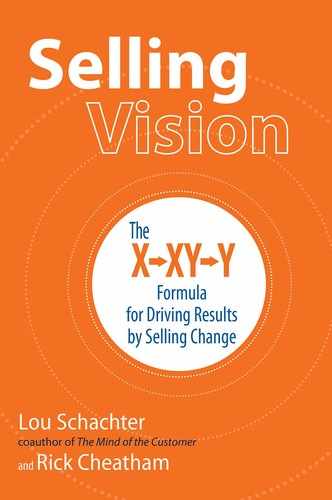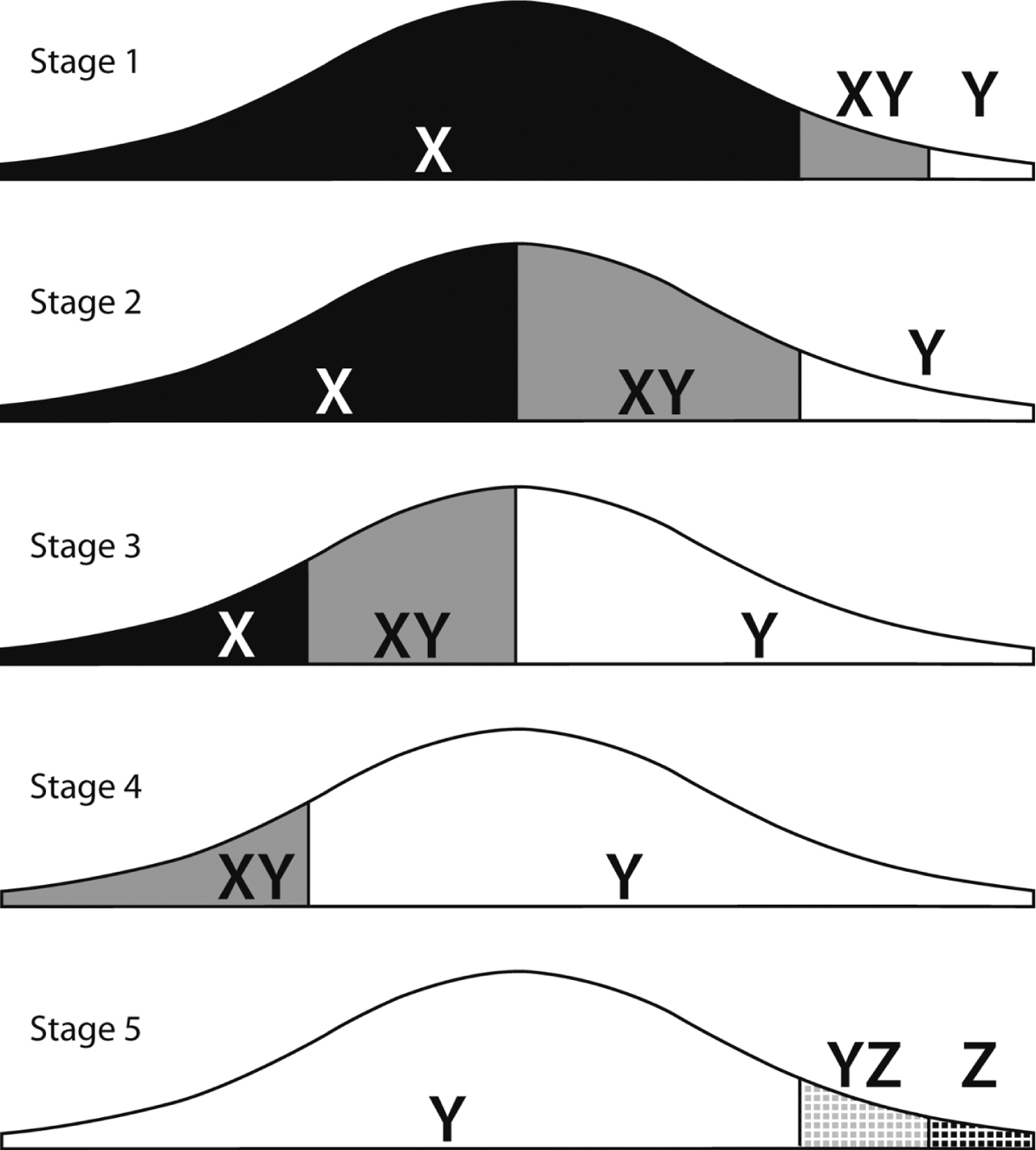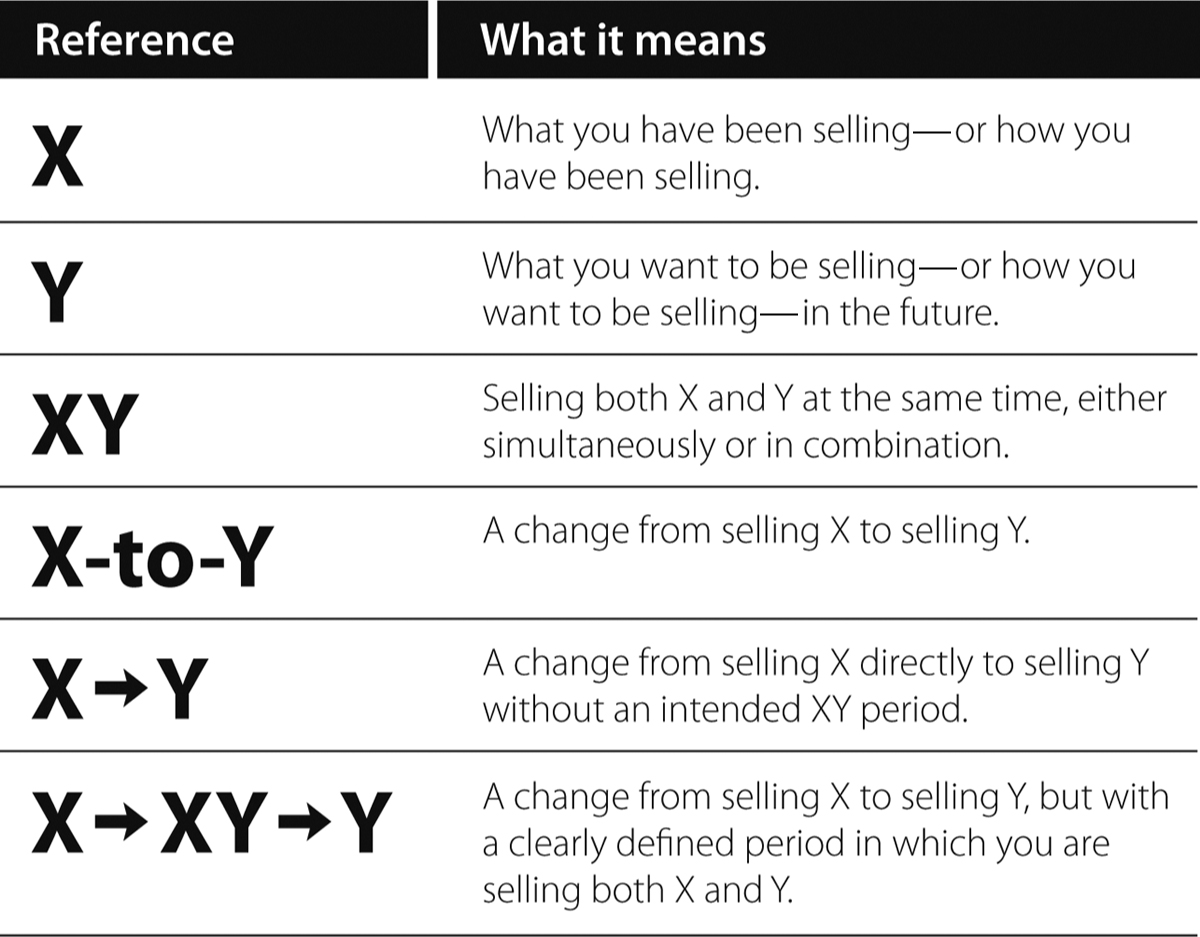CHAPTER 2
A New Way of Seeing Change
A number of books and papers have provided models for how companies’ go-to-market approaches must adapt to change. We propose a simple model, where a company is in a shift from selling a lot of X and a little bit of something new called Y … to a lot of Y and much less of the X legacy offering, as shown in Figure 2.1.
Figure 2.1 A shift from selling a lot of X and a little Y to less X and more Y.
X and Y can be what you sell or how you sell. What you sell may be shifting to radically new products or to radically new services. How you sell may involve new types of customers, new types of buyers within existing customer organizations, or new, fundamentally different selling approaches.
More specifically, some examples of the shift from X to Y can be:
![]() A change from selling on-premise software to offering cloud solutions
A change from selling on-premise software to offering cloud solutions
![]() A shift in pricing models from an approach that requires significant up-front payments to one that is based on monthly subscriptions
A shift in pricing models from an approach that requires significant up-front payments to one that is based on monthly subscriptions
![]() A change from selling equipment to leasing equipment
A change from selling equipment to leasing equipment
![]() A need to move from selling print advertising to digital advertising
A need to move from selling print advertising to digital advertising
![]() An effort to move salespeople from focusing on selling product features to selling the results the products will generate
An effort to move salespeople from focusing on selling product features to selling the results the products will generate
![]() A change from selling to technical buyers to selling to C-suite buyers
A change from selling to technical buyers to selling to C-suite buyers
![]() A shift from selling direct to selling through a channel (or the reverse)
A shift from selling direct to selling through a channel (or the reverse)
![]() A change from selling the value of product features to selling the business impact of both products and ancillary services
A change from selling the value of product features to selling the business impact of both products and ancillary services
Sometimes a new competitor introduces a Y offering into the X marketplace, and the big X players have no choice but to provide a Y alternative. This is what’s happened in the cloud space. But it’s also happened to taxi companies, with the advent of Uber. Often though, companies figure out Y on their own, frequently in collaboration with one or more of their biggest customers.
Initially a company is selling a lot of X and a little bit of Y. It looks like the pie chart in Figure 2.2, if you were to measure revenue or volume.
Figure 2.2 Y represents a small share of revenue or volume.
Over time, if the strategy works, the idea is that the share of Y gets bigger. The progression looks something like that shown in Figure 2.3.
Figure 2.3 The share of revenue or volume from Y gets bigger.
As you can see, at the end, there comes a point when Y is no longer the new thing. Z emerges, and the process repeats itself.
What People Think Happens
Now let’s look at how salespeople change as a result of a shift from selling X to selling Y. This is where it gets interesting. Let’s start with what people think happens.
In the beginning, as shown in Figure 2.4, we have a few people selling Y, while most people are selling X. The diagram represents a normal distribution curve, showing the number of salespeople doing each type of selling.
Figure 2.4 In the beginning, there are just a few salespeople selling Y.
Then, the conventional wisdom says, over time you get more of your X salespeople to sell Y. This is usually where the hard work occurs, but with success, over time the progression is expected to look more like that shown in Figure 2.5. In time, as the figure shows, more and more salespeople sell Y. And at the end, before the cycle repeats, some of them start to sell Z.
Figure 2.5 The conventional wisdom is that over time more salespeople switch from selling X to selling Y, and a few early adopters ultimately begin to sell Z.
Based on this model, sales leaders see it as their job to get more salespeople to sell Y more quickly. And that is hard. People resist change, especially big change. Typically, most salespeople who are told (or even taught) to start selling Y revert fairly quickly to selling X, as they always did. Sales leaders become frustrated by their inability to drive the shift they need. They often begin to wonder if they need new salespeople. They initiate an effort to recruit Y salespeople, often at great expense, and begin to let go X salespeople who can’t make the shift to Y, which is also expensive.
Salespeople can be tremendously frustrated. Often executive discussions about a shift from X to Y can take months. Once a decision is reached, the leaders, who have had a significant period of time to consider and accept the change, now expect salespeople to commit to it fully as soon as it is announced. Typically, salespeople, who have heard many big announcements over the years, wait things out to see if the change will stick, since so many before it have not.
Sales managers are often stuck in the middle between sales representatives who resist the change from X to Y and executives who insist upon it. The sales managers, themselves, often have mixed feelings about the new approach and are torn between being candid about their doubts and feeling an obligation to display confidence about the new direction.
There is a better way. Sales professionals who find themselves in this situation will benefit from looking at the situation differently.
What Really Happens
Driving a sales transformation—or even just being part of one—gets a whole lot easier when you realize the model above is not accurate. The shift from selling X to selling Y does not occur that way. It’s not a binary event, where you turn off X and turn on Y. Thinking it’s like a switch is what creates frustration for so many sales leaders and what creates resistance from salespeople and confusion in sales managers.
Let’s look again at how salespeople change as a result of a shift from selling X to selling Y. What really happens is that in the beginning, as shown in Figure 2.6, we have a very few people selling purely Y, while most people are selling X, and a few are selling a combination we’ll refer to as XY. That is, they are continuing to sell X while also selling Y. That is what happens in real life.
Figure 2.6 On the transition from selling X to selling Y, salespeople go through a transition where they sell both X and Y.
There will always be a few pure Y sellers (often new to the organization, sometimes from another firm that sold purely Y, or perhaps part of the original effort to introduce Y), but most people selling Y will still be selling a fair amount of X too. The salespeople are sometimes selling both X and Y at the same time; sometimes they are selling to their customers a combination solution that includes both X and Y.
The recognition of the XY combination is the key to understanding sales transformation. Over time, as you see on the distribution curves in Figure 2.6, salespeople do shift to selling Y exclusively. But they only do that after a period of selling both X and Y simultaneously.
The most critical element of making a sales transformation successful is describing what it looks like to sell X and Y at the same time or to sell XY combinations. It is not, as most sales leaders wrongly assume today, simply defining Y and how to sell it. Nor is it getting people to switch from X to Y. The key is getting them to switch from selling only X to selling X and Y at the same time.
In our experience, Stage 2 is the critical moment that determines success or failure. Here’s why:
![]() In Stage 1, you have a few of the original pure-Y sellers, and you have some XY sellers, who have likely figured out on their own how to sell both ways at once or combinations. These are typically some of your best salespeople who are also agile and always looking for the next new thing. They don’t need much guidance. They figure out what works and adopt new approaches quickly, as long as they see genuinely positive reactions from customers.
In Stage 1, you have a few of the original pure-Y sellers, and you have some XY sellers, who have likely figured out on their own how to sell both ways at once or combinations. These are typically some of your best salespeople who are also agile and always looking for the next new thing. They don’t need much guidance. They figure out what works and adopt new approaches quickly, as long as they see genuinely positive reactions from customers.
![]() In Stage 2, you actually have to work to get X sellers (the majority of your historically successful salespeople) to adopt the XY selling approach. That is hard, and it’s made harder by trying to get X salespeople to sell Y. We have worked with dozens of the largest and most admired sales forces in the world as they execute sales transformations. What we have discovered is that instead of driving X salespeople to sell Y, what successful sales leaders do is get X salespeople to begin selling XY. Later, we’ll go deeper into exactly how to do that. But if you don’t get Stage 2 right, you won’t see the later stages. You’ll likely be looking for a new job. If you do get Stage 2 right, the later stages will take care of themselves, to a great extent.
In Stage 2, you actually have to work to get X sellers (the majority of your historically successful salespeople) to adopt the XY selling approach. That is hard, and it’s made harder by trying to get X salespeople to sell Y. We have worked with dozens of the largest and most admired sales forces in the world as they execute sales transformations. What we have discovered is that instead of driving X salespeople to sell Y, what successful sales leaders do is get X salespeople to begin selling XY. Later, we’ll go deeper into exactly how to do that. But if you don’t get Stage 2 right, you won’t see the later stages. You’ll likely be looking for a new job. If you do get Stage 2 right, the later stages will take care of themselves, to a great extent.
As we go forward in our discussions, we’ll talk about the difference between two ways of seeing sales transformation:
X → Y
The Selling Vision Approach:
X → XY → Y
Table 2.1 provides an easy way to see how we will use these terms throughout this book.







